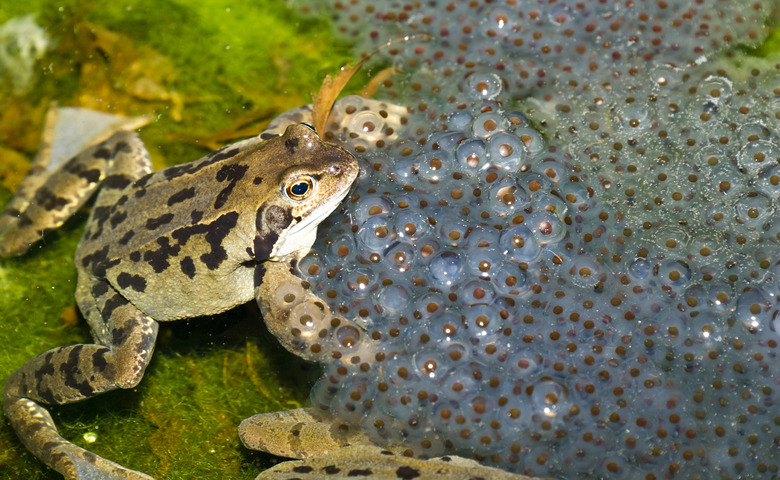External Fertilization In Chordates
The phylum Chordata represents the whole diverse array of vertebrates - animals with a vertebral column – as well as lancelets and tunicates. Two fertilization strategies are employed by members of phylum Chordata: internal fertilization, where the gametes, or sperm and egg, meet inside the body of one parent; and external fertilization, where sperm and egg meet outside the body. External fertilization is necessarily limited to aquatic environments, since sperm need a liquid medium to swim through in order to reach an egg.
Internal vs. External Fertilization
Internal vs. External Fertilization
Within chordates as a phylum, there are some great examples of both internal fertilization and external fertilization. The benefits and drawbacks of internal and external fertilization are pretty much the opposite of one another. For example, one benefit of external fertilization is that many eggs can be fertilized at one time. However, those eggs tend to be very vulnerable, which is one of the reasons why making so many might be necessary.
On the other hand, internal fertilization is much more limited. Often only one or a few eggs can be fertilized at one time, but those eggs might be more protected, either by a shell or the mother's body. The tradeoff here is that more energy is spent per egg, but they are more likely to survive.
Short-lived aquatic species, like fish and amphibians, tend to reproduce through external fertilization. Because most of the eggs won't survive, many are produced cheaply in somewhat of a "shotgun" approach to reproduction.
Internal fertilization enables animals to have longer gestation periods. This is important for long-lived, large animals like mammals. While fewer offspring are produced, they often have a much better chance of survival.
Subphylum Cephalochordata
Subphylum Cephalochordata
Cephalochordata is a very small subphylum made up of species of lancelets. Lancelets are small, fish-like animals that represent some of the most primitive characteristics of the phylum, including a dorsal nerve chord supported by a notochord rather than a spine.
Females and males produce eggs and sperm, respectively, from sets of paired gonads, and release them simultaneously for fertilization during the spawning season. During spawning, the gonads of the lancelets rupture and the gametes are flushed out into the water. The fertilized gametes form fish-like larvae.
Subphylum Urochordata
Subphylum Urochordata
The subphylum Urochordata, also known as tunicates, may not seem to belong in the phylum Chordata at first glance. Tunicates generally only have notochords in the larval stages and the adults are frequently completely immobile, looking as much like plants as animals.
Tunicate reproduction is a complicated affair. Some tunicates reproduce asexually, and of those that reproduce sexually, most are hermaphrodites, producing both male and female gametes. Some colonial species hold eggs and take in sperm through their siphon, or mouth, but solitary species release both eggs and sperm for external fertilization. Fertilized eggs form a free swimming tadpole that finds a new home and becomes an immobile adult.
Subphylum Vertebrata: Fish
Subphylum Vertebrata: Fish
Some fish are capable of live birth, but most use external fertilization. Spawning behavior varies among fish species, but commonly one or both parents prepare a nest for the eggs to rest on. There is a courtship ritual to ensure that the eggs and sperm meet for fertilization and then both individuals release large numbers of gametes.
Some fish species continue to provide some parental care, such as mouth brooding, where one parent (in some species it's the female; in others the male) allows the young to shelter from predators in his or her mouth; but most young fish, or fry, are on their own.
Subphylum Vertebrata: Amphibians
Subphylum Vertebrata: Amphibians
Amphibians live part of their lives in the water and part on the land, but almost all frogs and most other amphibians use external fertilization in aquatic environments to breed. Whether a pond or the well of a leaf, the female and male meet on a breeding ground, where the female deposits a mass of eggs and the male deposits sperm on top of the mass. The eggs of most amphibians develop into an aquatic larval stage that undergoes metamorphosis to an amphibious adult.
Cite This Article
MLA
Becker, Andrea. "External Fertilization In Chordates" sciencing.com, https://www.sciencing.com/external-fertilization-chordates-21619/. 30 September 2021.
APA
Becker, Andrea. (2021, September 30). External Fertilization In Chordates. sciencing.com. Retrieved from https://www.sciencing.com/external-fertilization-chordates-21619/
Chicago
Becker, Andrea. External Fertilization In Chordates last modified August 30, 2022. https://www.sciencing.com/external-fertilization-chordates-21619/
